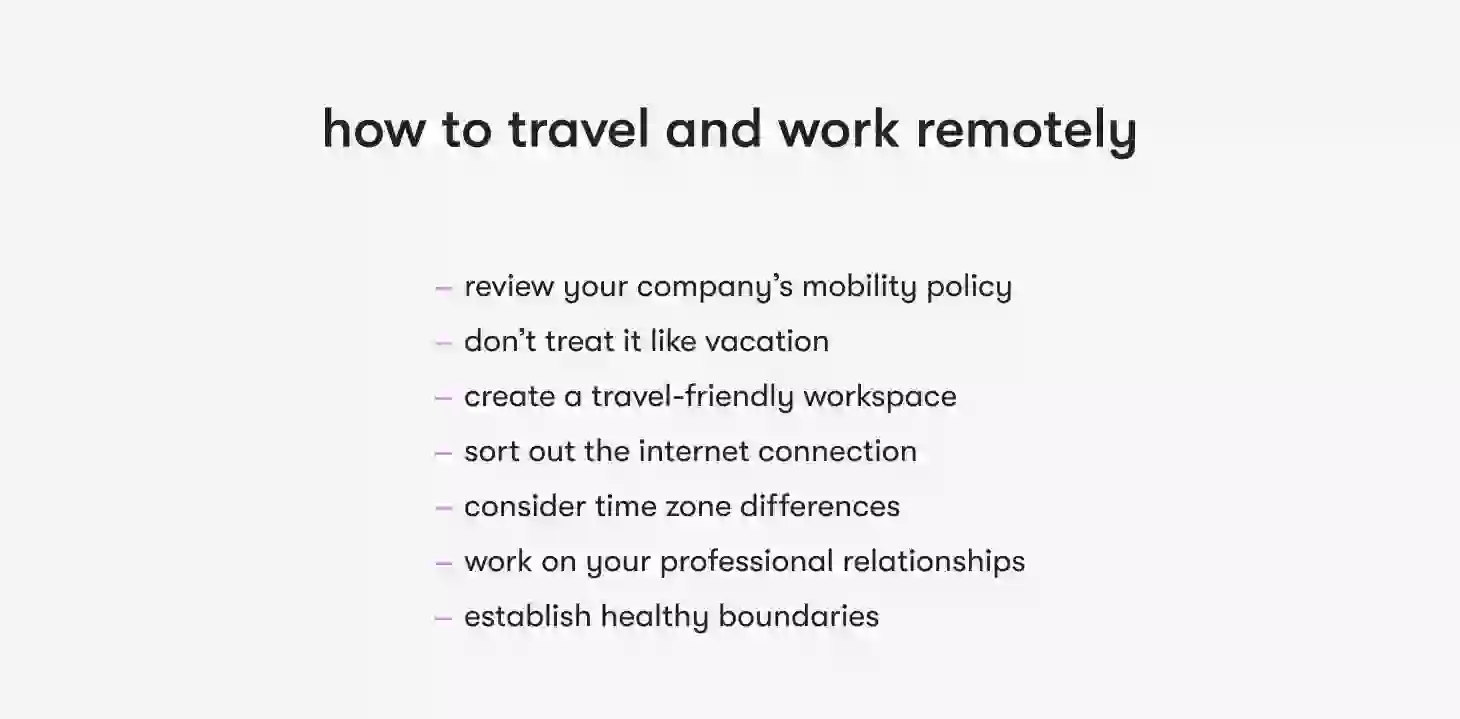For those who like to explore the world, figuring out how to work remotely and travel is often essential. It’s important to remember that there are rules professionals need to follow regarding travel as remote employees. Additionally, there are some legal complexities to navigate, as well as some preparation to ensure productivity. Here’s a look at how to successfully travel and work remotely.
Traveling while working remotely as a digital nomad
Digital nomads are professionals who perform their duties while traveling the world. The term is most commonly associated with self-employed professionals such as freelancers or independent contractors; however, remote workers who are employees of a specific company can also fall into this category.
For those operating as freelancers or independent contractors, the companies they work for typically can’t restrict their location since they aren’t officially employees of the company. Instead, the workers function as third-party service providers, which gives them more freedom. As a result, they can travel between various cities and countries without risking their employment, making working remotely from another country easier.
For remote employees of a company, there are typically restrictions regarding their travels. Employers often have location-based requirements to maintain employment eligibility, which are discussed in greater detail below. As a result, digital nomads who are remote employees have to exercise caution while traveling to other countries or working remotely from another country, though they can typically move within their home country without restriction.
Working remotely as a full-time employee while traveling
Traveling while working remotely as a full-time employee is a bit more complex than being a freelancer or independent contractor living as a digital nomad. As mentioned above, employers often have location-related restrictions in place for various reasons.
Typically, vacations aren’t restricted. However, there are usually rules regarding temporary relocations, particularly to other countries. Extended stays can alter an employee’s residency status. If their official residency shifts to another country, their eligibility to work for the company may change. Additionally, relocations can alter a professional’s tax status, causing them to owe income taxes in two countries. There are also potential issues regarding health insurance, retirement accounts, and other benefits.
For hybrid remote employees, relocating typically isn’t an option. These employees usually need to spend some of their time in the company’s physical office. As a result, moving to another city or country — either short-term or permanently — isn’t usually an option, as it makes meeting the in-office attendance requirements challenging, if not impossible.
However, traveling for vacations and short-term relocations to cities within the same country are often possible. Even stays in other nations are possible if the employee gets the proper approvals and their tax and residency status won’t change. As a result, full-time remote employees can still explore the world as long as they follow the rules of their employer.
Additionally, it’s possible to have a rewarding career while working remotely and traveling. Many professionals wonder if remote workers can still climb the career ladder, and the answer is “yes.”
Remote team members can grow, develop, and advance like their in-office colleagues. However, it can take extra effort since remote employees are less visible and need to work diligently to build strong relationships with higher-ups.
I’ve always loved traveling, so the fact that the job at EPAM Anywhere was 100% remote was a big factor for me.

How to travel and work remotely: 7 smart tips

1. Review your company’s mobility policy
Unless you’re working as a freelancer or independent contractor, working remotely while traveling is usually governed by your employer. Make sure to review your company’s mobility policy before making travel plans.
Determine whether you need pre-approval before heading to another area and what process is required to secure approval. See if there are restrictions regarding your duration of stay, so you can ensure you return home at the right time.
You also need to see if there are rules regarding your work-time availability, particularly if you’re traveling to a country in a different time zone. If being available is mandatory during specific hours based on the time zone of your company’s office, you might need to wake up early or stay up late, depending on your destination country’s time zone. You’ll need to decide whether you’re comfortable with that before proceeding.
2. Don’t treat it like a vacation
Traveling while working remotely gives professionals a chance to explore the world, but you shouldn’t treat these trips like vacations. You need to remain focused on your professional responsibilities, as failing to meet expectations harms your career and potentially makes you eligible for disciplinary action, including termination.
Changing locations takes time and energy. As a result, productivity dips on days surrounding your transition to a new place often occur. You need to plan for these moments accordingly, ensuring you either schedule the moves on non-work days with enough space to recuperate or make up for the lost productivity on other days.
Additionally, plan any sightseeing for non-work hours, such as nights and weekends. For activities that need to take place during the work day, either commit more hours to your work during the preceding week to ensure you stay on target or schedule vacation time with your employer before making those plans.
3. Create a travel-friendly workspace
When you’re figuring out how to work remotely and travel, one of the most significant points you need to cover is ensuring you have a functional home workspace. While traveling, you can’t typically bring every home office item with you. Instead, you need to plan for a pared-down version that is portable.
Generally, the minimum you’ll need is a computer. You might also want to bring various peripheral devices, such as a mouse and webcam.
Make sure your destination accommodations have a usable surface for a desk. Similarly, it’s wise to choose a hotel that makes printers and scanners available to guests. Otherwise, you can select accommodations near coworking spaces, as you can typically rent a desk for short periods and get access to a variety of office equipment while there.
Additionally, have a comfortable home office available for times you return from your travels. That ensures you can quickly get back to work once you return home.
4. Sort out the internet connection
Another key consideration when figuring out how to travel and work remotely is ensuring you’ll have a suitable internet connection at your destination. Many companies have speed requirements outlined in their remote work policies, and not all locations can support the minimum speed.
In addition, the free Wi-Fi at local hotels, cafés, or similar destinations might not only be slow, it may fall short when it comes to security. As a result, relying solely on it comes with risks, particularly if you aren’t connecting to work resources through a VPN or similar security-oriented service.
Using a mobile hotspot may also fall short of the speed requirements. Cellular service quality varies dramatically across the world, so don’t assume this option can make up for lackluster local internet speeds. Instead, research all of your options in advance to ensure you can find a workable solution.
5. Consider time zone differences
As mentioned above, many companies that hire full-time remote employees have expectations regarding availability. You need to make sure you’re online and working during any mandatory time periods. Since that’s the case, understanding any time zone differences when you travel is essential.
For example, if you need to start your work day at 8 am GMT, you’d have to begin working at midnight if you’re traveling to the west coast of the United States — such as Los Angeles, California — since cities in that area are in the Pacific Time Zone.
Even if availability during specific times isn’t required, knowing how the time zone where you’re staying differs from your home location is essential. Your colleagues aren’t always available during periods when you’re working. When you reach out for information you need to complete your tasks, you might not get responses for hours. Asynchronous communication is complex and delay-ridden, and you need to plan accordingly.
6. Work on your professional relationships
Physical distance and time zone differences can hinder work relationships. As a result, it’s critical to ensure you go the extra mile to maintain existing connections. Make use of virtual options available through your company, including messengers, video conferencing solutions, and email.
If possible, communicate with colleagues and managers using video chat regularly, so you can get some face time. Couple that with regular written status updates regarding your work progress, as well as casual interactions to stay up to date regarding other people’s lives.
Usually, it’s best to default to overcommunicating, particularly initially. With that strategy, critical details won’t fall through the cracks. Plus, you’ll remain engaged with your colleagues, which is a crucial part of the equation.
7. Establish healthy boundaries
Remote workers often struggle when it comes to maintaining healthy professional boundaries. Primarily, this occurs since their office is within their home or travel accommodations. As a result, it can be challenging to walk away at the end of the workday, which can lead to poor work-life balance.
Since part of the joy of traveling as a remote employee is exploring new areas, make sure to establish healthy boundaries regarding your work. Have a discussion with your manager in advance to clarify expectations, so you can ensure you're working at the proper times and fully disconnecting when the workday is done.
Important considerations for working remotely while traveling
Traveling while working remotely is exciting and convenient for many professionals, but there are some critical points to consider.
First, make sure to check your employer’s remote work and mobility policy to ensure you’re aware of any requirements or restrictions. Rules vary from one company to the next, so checking is essential.
Second, understand any travel requirements for potential destination countries. You might need a specific type of visa, and the process for getting one can range from simple to complex. Checking local employment laws is also potentially a must, particularly if you’re staying for an extended period.
There are also financial considerations you need to factor into the equation. For example, the cost of living varies between cities and countries, so it’s best to see how your expenses may change as you travel. Otherwise, you may find yourself falling short unexpectedly.
Next, figure out the taxation. Generally, employees pay taxes based on their country of residence. If a professional is only traveling to other countries for short periods and returns home regularly enough to maintain residency, they’ll only owe taxes in their home country.
However, extended stays can alter their tax status, either causing them to become a resident in a new country or lose their residency in their home country. If a professional ends up a resident in two countries, they’ll owe taxes in both. If they lose their home residency, they may only owe taxes in the new nation. However, they could end up ineligible for employment with their current employer, causing them to lose their job.
As a result, professionals need to review their company’s policies and travel requirements at their destination country before making plans. Additionally, it’s wise to check residency rules in both your home country and the places you’re traveling. That way, you can follow any employer rules and maintain proper residency, reducing the odds of tax-related complications.
Ready for a remote-forever job in tech that offers freedom and flexibility paired with the reliability of full-time employment? Explore our open jobs at EPAM Anywhere and feel free to apply.

With a focus on remote lifestyle and career development, Gayane shares practical insight and career advice that informs and empowers tech talent to thrive in the world of remote work.
With a focus on remote lifestyle and career development, Gayane shares practical insight and career advice that informs and empowers tech talent to thrive in the world of remote work.
Explore our Editorial Policy to learn more about our standards for content creation.
read more























